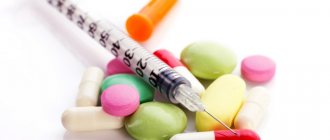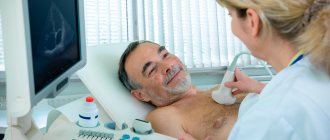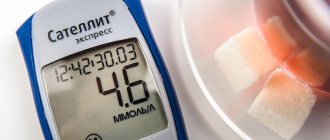Lipodystrophy is a pathology in which thinning and inability to create adipose tissue occurs (atrophy) or, conversely, its compaction and thickening (hypertrophy). Lipodystrophy often occurs in diabetes mellitus, which is accompanied by the use of insulin. To understand why dystrophy occurs and how to deal with it, you need to understand how insulin therapy is carried out.
The disease leads to a serious cosmetic defect
What it is?
Lipodystrophy is a disorder of the formation of adipose tissue. The disease can be either congenital or appear against the background of other pathologies or the use of medications (for example, in the treatment of diabetes). The fat layer with lipodystrophy becomes altered.
If the disease is associated with insulin, then, as a rule, atrophy or lipodystrophy begins to appear at the injection sites. Eliminating cosmetic defects that have arisen is extremely problematic, so people who are undergoing therapy with insulin injections into adipose tissue should know how to prevent this pathology.
Important! If you have diabetes, treatment should be comprehensive. It is recommended to strive to reduce insulin dependence through proper diet and a healthy lifestyle.
More information about lipodystrophy in the video:
Types of lipodystrophy
In diabetes mellitus, there are two types of lipodystrophy:
- Atrophy of adipose tissue;
- Hypertrophy of adipose tissue.
Atrophy occurs most often - in 80% of cases. And only 20% is due to hypertrophy.
Atrophy is the underdevelopment of adipose tissue at the sites of insulin administration. Atrophy does not affect other areas of the body and does not spread anywhere.
In fact, it looks as if there is a complete absence of adipose tissue at the injection site; in these places there are hollows that are very clearly visible.
For many, this is a significant physical disability.
Hypertrophy, on the contrary, is expressed in the growth of adipose tissue. Areas affected by hypertrophy look like uneven fat mounds.
At first, the fat deposits are not very large, but over time they increase. Hypertrophy also appears only at the sites where insulin is administered, without affecting other areas of the body.
Most often, atrophy, like hypertrophy, develops on the abdomen. Since these places are most convenient for insulin injections and are often the main places for insulin administration.
Types and features of pathology
The type of lipodystrophy is determined based on the nature of its origin. The primary disease is usually associated with congenital characteristics of the body. Acquired thinning and other defects of the fatty surface may be associated with the following pathologies:
- diabetes accompanied by insulin therapy;
- HIV;
- Barraquer-Simons syndrome.
Injecting drugs into the same place over a long period of time leads to changes. If at the same time a person experiences any other diabetic complications or suffers from liver diseases or acute intoxications, then the risk of developing lipodystrophy increases.
If lipodystrophy occurs against the background of diabetes, then a fairly serious threat to health appears. Atrophy can lead to poor absorption of insulin, which in turn will cause an increase in blood sugar. Hypertrophy can be complicated by suppuration, which will subsequently lead to gangrene.
What are the risks of developing lipodystrophy?
Lipodystrophy is a very unpleasant disorder. This complication is not fatal, but it carries certain inconveniences that must be taken into account in the further treatment of diabetes mellitus.
- Atrophy and hypertrophy lead to impaired absorption of insulin, which leads to surges in sugar and the inability to clearly select the required doses of insulin;
- Atrophy can lead to the development of insulin resistance, which will lead to more complex problems;
- Hypertrophy can lead to the appearance of coffee ulcers and the development of skin infections, which are difficult to treat in diabetes mellitus and can lead to disastrous consequences;
- Lipodystrophy is also an external defect, which also affects lifestyle.
Reasons for appearance
In diabetes, tissue lipodystrophy develops due to improper use of insulin. The following factors can act as a trigger:
- use of old or poorly purified insulin preparations;
- reuse of a disposable syringe pen needle for injection;
- insulin dose higher than 10.1 units per day;
- no change in locations where injections are given.
Impaired creation of adipose tissue in the abdominal area
If injections are constantly given in one place on the abdomen without changing the location, then the fatty and subcutaneous tissue begins to change quickly. Compaction or, on the contrary, lipodystrophy occurs. At first, the lump feels like a small bump.
The likelihood of lipodystrophy also affects the presence of other chronic diseases. To carry out prevention, it is necessary to eliminate all provoking factors, achieve remission in the treatment of indolent diseases and prevent an increase in sugar.
Treatment of lipodystrophy
There is no cure for lipodystrophy as such. There are only methods aimed at improving insulin absorption, improving blood supply to affected areas, and activating the formation of adipose tissue during atrophy.
Methods used to treat the consequences of lipodystrophy:
- Changing injection sites - do not inject insulin into the affected areas;
- Massage of the affected areas - blood supply improves and the resorption of fat mounds accelerates;
- Warming up fat mounds with paraffin;
- Electrophoresis;
- Ultrasound on affected areas;
- Hormone therapy for atrophy.
And it is important to remember that it is easier to prevent complications from developing than to try to get rid of the consequences later.
Lipodystrophy in diabetes mellitus
The complication develops slowly. It usually takes 6 to 24 months of insulin misuse for the first signs of lipodystrophy to appear. If diabetes is severe and injections are given frequently, you need to carefully select the injection site so that processes associated with changes in the subcutaneous tissue do not begin in the future.
If the area that has undergone dystrophic changes becomes too large, it will be extremely problematic to make the necessary daily injections. That is why, after prescribing insulin therapy, it is necessary to approach treatment with great responsibility.
If a person discovers lipomas and other changes in the subcutaneous tissue, he should immediately consult a doctor. At the initial stage, lipodystrophy is much easier to fight.
If diabetes causes a deficiency of vitamins and microelements important for the body, then the diet will need to be adjusted in such a way as to eliminate the deficiency. Your doctor may prescribe special supplements. To monitor your general condition, you need to undergo regular examinations in a hospital setting. You should also choose the correct dose of insulin to ensure that glucose is absorbed correctly.
Symptoms and manifestations
Lipodystrophy can be recognized by the following symptoms:
- changes in abdominal fat density;
- the occurrence of dystrophic local changes;
- appearance of visual defects.
Lipodystrophy affects up to 24% of all people treated for diabetes using insulin. Most often, the defect is detected in women and children. In addition to physiological and visual manifestations, the pathology leads to a deterioration in insulin absorption. All this negatively affects diabetes therapy and worsens a person’s overall well-being.
Internal changes in subcutaneous fat tissue in lipodystrophy
If you want to reduce the likelihood of developing this complication, then you need to switch to the use of highly purified insulin preparations, and also avoid using the same needle more than 2 times.
Treatment methods
Various methods can be used for therapy. To get rid of disorders of subcutaneous adipose tissue, the following methods are used:
- physiotherapy;
- massage;
- changing the site of insulin administration (at least temporarily).
To facilitate the administration of insulin, you can additionally use novocaine. A specific treatment regimen should be drawn up by a doctor, taking into account the individual characteristics of the person.
The use of physiotherapeutic methods is permissible only after the permission of the treating specialist
Playing sports will help increase the effect of therapeutic effects. Light physical exercises that indirectly engage the abdominal muscles will help fight emerging dystrophy, and will also help eliminate old changes. The doctor may prescribe a complex of physical therapy. Proper nutrition also plays an important role both in the fight against the underlying disease and its complications.
Important! It may take several months for the dystrophic element to resolve. In some people with a predisposition to developing keloids, the lump or lipodystrophy may remain in some form permanently.
Prevention of complications
To prevent the appearance of lipodystrophy of adipose tissue, the following actions must be taken:
- always change the needle, even if there is still insulin left inside the syringe;
- carry out regular inspection of injection sites for the appearance of seals;
- use different areas of the abdomen for injections;
- use only highly purified insulin medications for therapy.
General preventive measures can also help prevent the development of dystrophic phenomena, including proper nutrition, regular activity and adjustment of therapy if complications of the condition occur. Systemic medications for general health may be used. A competent approach to therapy can reduce the likelihood of encountering any complications.
It is necessary to regularly monitor your sugar using a home glucometer
It is worth noting that high-quality prevention can be ensured only if the rules for using insulin drugs are followed. If your doctor has recently prescribed replacement therapy, you should carefully study all the nuances of its implementation. This will be the key to long-term and problem-free treatment of diabetes.
Prevention of lipodystrophy
Lipodystrophy is a disease that is difficult to cure completely, if not impossible. But you can prevent its development.
To prevent lipodystrophy from making itself felt, you need to follow some simple rules when administering insulin:
- Firstly, it is very important to change the injection site with each injection. You can create a schedule for changing injection sites by dividing insulin injection sites into small sections. The next injection of insulin should be 2-3 cm further from the previous one;
- Secondly, it is important to carry out the injection itself correctly - inject insulin subcutaneously, hold the needle at an angle, and, if necessary (in case of injecting insulin into the abdomen), make a small fold of skin;
- Thirdly, insulin should be at room temperature; do not administer insulin that has just been taken out of the refrigerator;
- Fourthly, change the needle on the syringe pen more often, do not allow the needle to become completely dull.
These simple rules will help you avoid very serious problems in the future.
How to prevent the condition from getting worse
Diabetes is an extremely dangerous disease if adequate measures are not taken to combat it. Any diabetic should adhere to the following rules while fighting their illness:
- elimination of all symptoms and complications of high sugar;
- regular glucose monitoring;
- fight against chronic pathologies in the body;
- relief and prevention of dystrophies that interfere with injections.
First of all, you need to eliminate all third-party diseases. In diabetes, any pathological lesion is more severe than in a healthy person. You should also adjust your diet by eliminating all fast carbohydrates, fatty and fried foods.
Lipodystrophy may appear several years after the start of replacement therapy. If all the rules of prevention have been followed, but the complication still makes itself felt, then you should try to use only long-acting insulin, maximizing the interval between injections. This will slightly improve the condition of fatty skin tissue.
Maintaining normal blood sugar levels is the main goal in diabetes treatment
You should regularly consult a specialist, especially if you need to somehow adjust the plan for combating the disease. The use of modern drugs and syringe pens for insulin allows us to avoid complications.
Alternating injection areas
Insulin injections are given in the stomach. To minimize harm to the fat layer, it is necessary to regularly alternate the areas of drug administration. Conventionally, the stomach can be divided into 4 squares. It is recommended to make each new injection 1 cm from the old one. The injection can also be carried out in the upper thigh and buttocks.
With proper planning and weekly rotation from one square to another, the subcutaneous tissue will have the opportunity to recover after injections. Thus, a collision with lipodystrophy will not occur even with extremely long-term treatment.
Scheme of possible use of a place for administering a drug for diabetes
To understand whether the area has recovered after the injection, you should carefully palpate it. If there are no compactions or visual changes, and more than 1 week has passed, then you can inject again in the same place.
Does excess weight affect lipodystrophy?
Too much body fat and excess weight negatively affect the general condition of the body. The likelihood of developing tissue hypertrophy also increases. It is recommended to try to follow a diet and set the dosage of the hormone so that the weight gradually decreases and is within the normal body mass index.
A diabetic diet should be balanced. The body must receive all the necessary micro- and macroelements. To prevent glucose from jumping too much, you need to exclude all sweets from your diet. Preference is given to complex carbohydrates, salads and steamed foods.
Important! The diet should be prepared in consultation with a qualified physician. Errors in nutrition lead to a deterioration in overall health and the progression of diseases along with its complications.











